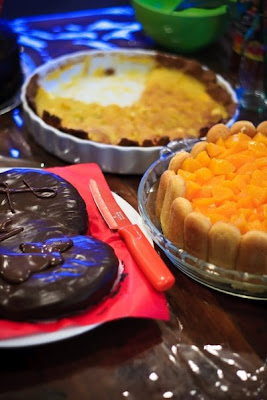 The spread of desserts here partly explain the absence from blogging. I've been cooking, eating, then more cooking and eating. Above picture courtesy of M, whom we had the pleasure of attending the party celebrating his engagement with LC.
The spread of desserts here partly explain the absence from blogging. I've been cooking, eating, then more cooking and eating. Above picture courtesy of M, whom we had the pleasure of attending the party celebrating his engagement with LC.  Our contributions include the peachy Charlotte, the tangy Lemon Tart, and Camille's Fondant au Chocolat.
Our contributions include the peachy Charlotte, the tangy Lemon Tart, and Camille's Fondant au Chocolat. And here's a useful tip, for those who wants to make heart shaped cake like me, but couldn't find a heart shaped tin after visiting some 6 stores in the city.
 Besides Camille's fondant, Rémi has also started the first experiment to find the right way to make a volcanic like French melted chocolate cake. Meaning when you use your dessertspoon to break the little warm cake, the chocolate just oozes out like hot lava.
Besides Camille's fondant, Rémi has also started the first experiment to find the right way to make a volcanic like French melted chocolate cake. Meaning when you use your dessertspoon to break the little warm cake, the chocolate just oozes out like hot lava.The idea is to bake the chocolate cake for a short time in a hot oven, so that the inside doesn't cook completely and hence it's still moist. We hope to try a few variations of recipes Rémi found on French websites. By the way, the white patches on the cake is my lame attempt at dusting icing sugar on the cake, they are not the results of a mouldy cake.

And finally, the ugliest looking cake of this whole lot, because me and Rémi are too busy with savouring it while it's still piping hot from the oven and only bother to take photo after the second day.
The recipe comes from Christelle Le Ru. First time we made it for the Chinese New Year reunion dinner, it was sooooo good that despite having a 101% full stomach, I went on for a second and possibly third slice. Second time, we couldn't repeat the success but not too bad still. Third time, yum yum. So I've decided to post the recipe, for my bro who have tried the first yummy attempt. The precious highly recommended recipe book was from them afterall.
Pear and Chocolate Cake
Serves 5? I've halved the proportion and the cake last us 3 desserts for 2.
2 eggs
100g sugar
a few drops of vanilla essence
85g melted butter
135g flour
1 tablespoon baking powder
3 sweet pears
100g dark chocolate
sliced almonds
Preheat oven to 160 degrees Celsius. Grease a loaf tin.
Beat eggs, sugar and vanilla essenee together. Add the melted butter and mix until everything is well combined. Fold the flour and baking powder into the cake mixture.
Peel and cut the pears into slices or cubes. Break the chocolate into small pieces. Stir the pears and chocolate pieces into the cake mixture. Do not worry if you find that there seems to be more pear than cake. The juiciness of the pears gives a moist sweet texture to the cake.
Pour into the tin and scattered sliced almonds over the top. Bake for 40 to 45 minutes. The cake is especially nice when it's warm, with the chocolate partially melted inside.












